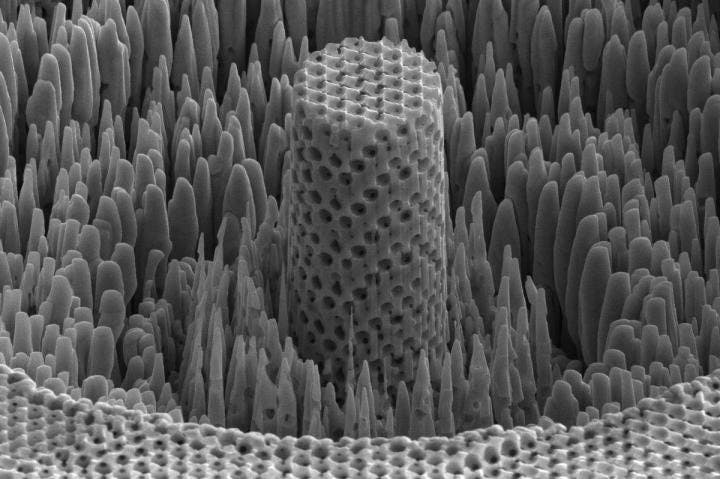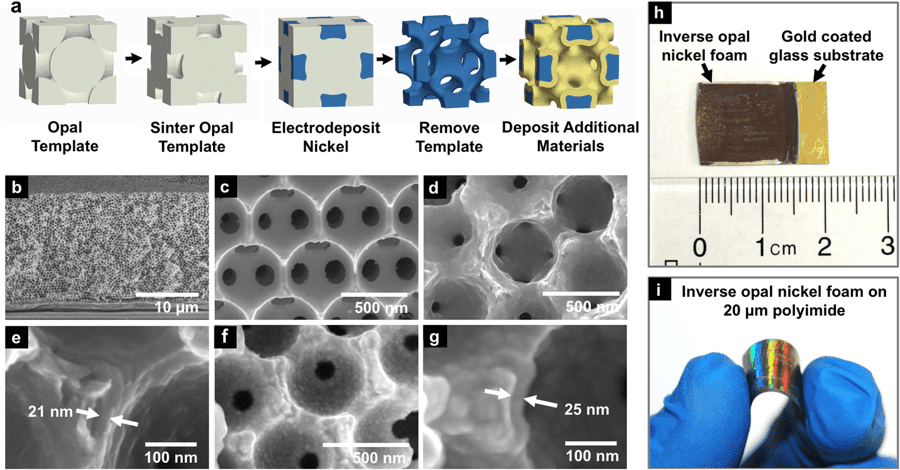A team of US researchers has developed a light, but incredibly strong new material — they’re calling it metallic wood. This material, despite being a porous sheet of nickel, is as strong as titanium but four to five times lighter.

Image credits University of Pennsylvania.
The way atoms stack in a lump of metal determines how strong that metal is — but we can’t (yet) produce such objects. For example, a sample of perfectly-stacked titanium would be ten times as strong as any titanium we can create today. This comes down to random defects that form in the manufacturing process, impacting the metal’s overall properties. Materials researchers have been trying to exploit this phenomenon by taking an architectural approach, controlling the metal’s nanoscale layout to unlock the mechanical properties that arise at the nanoscale, where defects have reduced impact.
In a new study, researchers at the University of Pennsylvania’s School of Engineering and Applied Science, the University of Illinois at Urbana-Champaign, the Middle East Technical University in Turkey, and the University of Cambridge have designed a new material in which every atom is carefully laid out in its correct place, leading to a surprisingly high strength-to-weight ratio.
Woody metal
“The reason we call it metallic wood is not just its density, which is about that of wood, but its cellular nature,” says lead author James Pikul, Assistant Professor in the Department of Mechanical Engineering and Applied Mechanics at Penn Engineering.
“Cellular materials are porous; if you look at wood grain, that’s what you’re seeing — parts that are thick and dense and made to hold the structure, and parts that are porous and made to support biological functions, like transport to and from cells.”
The team writes that the material’s porous nature and the self-assembly process in which it’s created make it akin to wood and similar natural materials. Their metallic wood is made up of dense, strong metallic struts surrounding empty pores. The design operates “at the length scales where the strength of struts approaches the theoretical maximum,” Pikul explains.
Pikul’s team started with tiny plastic spheres of a few hundred nanometers in diameter, which they suspended in water. As the water slowly evaporated, the spheres stacked onto each other into an orderly, crystalline framework. The spheres were electroplated with nickel, then dissolved — leaving behind a network of metallic struts.

Each strut is around 10 nanometers wide, which is roughly the length of 100 nickel atoms, they explain. The team favored this production method over other techniques like 3D-printing as it’s easier to scale up.
“We’ve known that going smaller gets you stronger for some time,” Pikul says, “but people haven’t been able to make these structures with strong materials that are big enough that you’d be able to do something useful. Most examples made from strong materials have been about the size of a small flea, but with our approach, we can make metallic wood samples that are 400 times larger.”
“We’ve made foils of this metallic wood that are on the order of a square centimeter, or about the size of a playing die side,” he adds. “To give you a sense of scale, there are about 1 billion nickel struts in a piece that size.”
Because some 70% of the material is empty space, it has extremely low density in relation to its strength. It’s just a tad less dense than water, meaning a block of this material could float while still being stronger than most metal alloys today.
In a somewhat ironic twist, this process of creating metallic wood (which is metal in a wood-like configuration) is the opposite of how researchers at the University of Maryland created superdense wood (which is wood in a metal-like configuration).
The team is now focusing on expanding the production process to commercially relevant sizes. The materials used aren’t particularly rare or expensive on their own, but the infrastructure needed to carry out the production process is currently very limited. If that infrastructure is developed, however, the team is confident that their metallic wood can be produced more quickly and cheaply than their prototype sample.
A larger production base would also allow the team to further test their creation. Since they’ve only produced a tiny sample in the lab, the team is limited in what macroscale tests it can run on the material.
“We don’t know, for example, whether our metallic wood would dent like metal or shatter like glass.” Pikul says. “Just like the random defects in titanium limit its overall strength, we need to get a better understand of how the defects in the struts of metallic wood influence its overall properties.”
Another exciting possibility is merging the metallic wood with other materials to tailor it to a wide range of applications. Infusing it with anode and cathode materials, for example, would essentially turn the metallic wood into a very solid battery.
“The long-term interesting thing about this work is that we enable a material that has the same strength properties of other super high-strength materials but now it’s 70 percent empty space,” Pikul says.
“And you could one day fill that space with other things, like living organisms or materials that store energy.”
For example, the material could be used to produce smart prosthetics that store their own power — which would be pretty sweet.
The paper “High strength metallic wood from nanostructured nickel inverse opal materials” has been published in the journal Nature.


